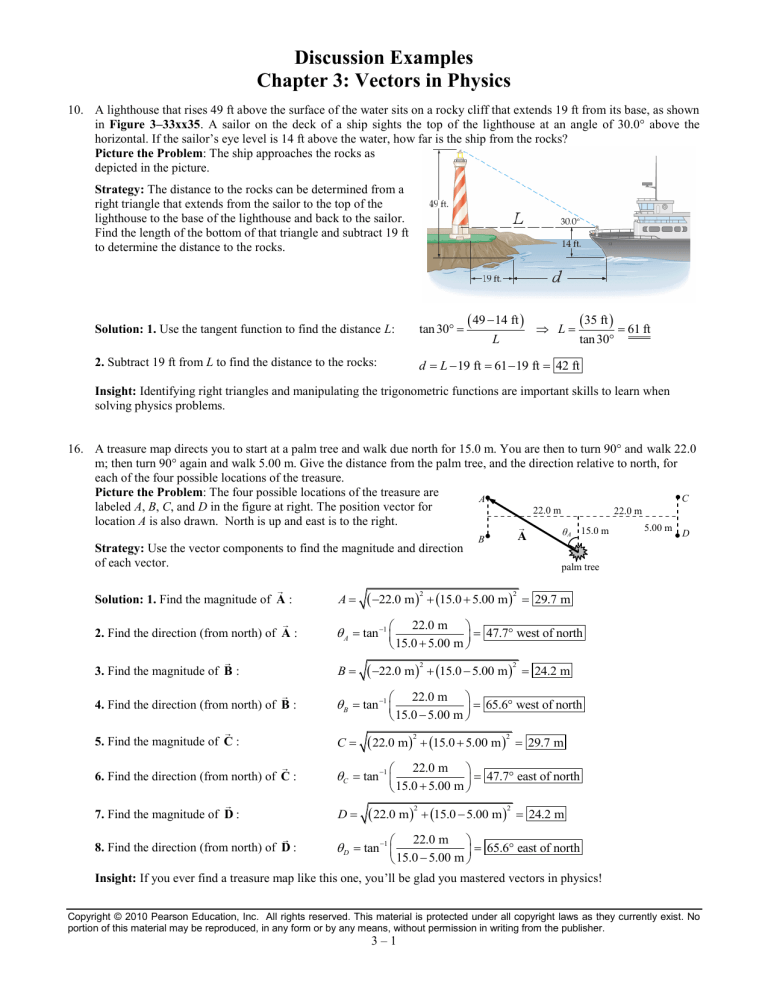
Discussion Examples Chapter 3: Vectors in Physics 10. A lighthouse that rises 49 ft above the surface of the water sits on a rocky cliff that extends 19 ft from its base, as shown in Figure 3–33xx35. A sailor on the deck of a ship sights the top of the lighthouse at an angle of 30.0° above the horizontal. If the sailor’s eye level is 14 ft above the water, how far is the ship from the rocks? Picture the Problem: The ship approaches the rocks as depicted in the picture. Strategy: The distance to the rocks can be determined from a right triangle that extends from the sailor to the top of the lighthouse to the base of the lighthouse and back to the sailor. Find the length of the bottom of that triangle and subtract 19 ft to determine the distance to the rocks. 49 14 ft tan 30 2. Subtract 19 ft from L to find the distance to the rocks: d L 19 ft 61 19 ft 42 ft L L 35 ft Solution: 1. Use the tangent function to find the distance L: tan 30 61 ft Insight: Identifying right triangles and manipulating the trigonometric functions are important skills to learn when solving physics problems. 16. A treasure map directs you to start at a palm tree and walk due north for 15.0 m. You are then to turn 90° and walk 22.0 m; then turn 90° again and walk 5.00 m. Give the distance from the palm tree, and the direction relative to north, for each of the four possible locations of the treasure. Picture the Problem: The four possible locations of the treasure are C A labeled A, B, C, and D in the figure at right. The position vector for 22.0 m 22.0 m location A is also drawn. North is up and east is to the right. 5.00 m θA 15.0 m D A B Strategy: Use the vector components to find the magnitude and direction of each vector. palm tree 22.0 m Solution: 1. Find the magnitude of A : A 2. Find the direction (from north) of A : A tan 1 3. Find the magnitude of B : B 4. Find the direction (from north) of B : B tan 1 5. Find the magnitude of C : C 6. Find the direction (from north) of C : C tan 1 7. Find the magnitude of D : D 8. Find the direction (from north) of D : D tan 1 2 15.0 5.00 m 29.7 m 2 22.0 m 47.7 west of north 15.0 5.00 m 22.0 m 2 15.0 5.00 m 24.2 m 2 22.0 m 65.6 west of north 15.0 5.00 m 22.0 m 2 15.0 5.00 m 29.7 m 2 22.0 m 47.7 east of north 15.0 5.00 m 22.0 m 2 15.0 5.00 m 24.2 m 2 22.0 m 65.6 east of north 15.0 5.00 m Insight: If you ever find a treasure map like this one, you’ll be glad you mastered vectors in physics! Copyright © 2010 Pearson Education, Inc. All rights reserved. This material is protected under all copyright laws as they currently exist. No portion of this material may be reproduced, in any form or by any means, without permission in writing from the publisher. 3–1 James S. Walker, Physics, 4th Edition Chapter 3: Vectors in Physics 21. An air traffic controller observes two airplanes approaching the airport. The displacement from the control tower to plane 1 is given by the vector A , which has a magnitude of 220 km and points in a direction 32° north of west. The displacement from the control tower to plane 2 is given by the vector B , which has a magnitude of 140 km and points 65° east of north. (a) Sketch the vectors A, B , and D A B . Notice that D is the displacement from plane 2 to plane 1. (b) Find the magnitude and direction of the vector D . Picture the Problem: The vectors involved in the problem are depicted at right. The control tower (CT) is at the origin and north is up in the diagram. Strategy: Subtract vector B from A using the vector component method. Solution: 1. (a) A sketch of the vectors and their difference is shown at right. 2. (b) Subtract the x components: Dx Ax Bx 220 km cos 180 32 140 km cos 90 65 310 km 3. Subtract the y components: Dy Ay By 220 km sin 180 32 140 km sin 90 65 57 km 4. Find the magnitude of D: D Dx2 Dy2 5. Find the direction of D: D tan 1 310 km 2 57 km 320 km 3.2 105 m 2 Dy 1 57 km tan 10 180 170 or 10 north of west 310 km Dx Insight: Resolving vectors into components takes a little bit of extra effort, but you can get much more accurate answers using this approach than by adding the vectors graphically. Notice, however, that when your calculator returns −10° as the angle in step 5, you must have a picture of the vectors in your head (or on paper) to correctly determine the direction. 41. You drive a car 1500 ft to the east, then 2500 ft to the north. If the trip took 3.0 minutes, what was the direction and magnitude of your average velocity? Picture the Problem: You travel due east 1500 ft then due north 2500 ft. Strategy: The components of the displacement are given, from which we can determine the magnitude and direction fairly easily. The direction of the average velocity will be the same as the direction of the displacement. The magnitude of the average velocity is the magnitude of the displacement divided by the total time of travel. Let north be the positive y direction and east be the positive x direction. ry 1 2500 ft tan 59 north of east r 1500 ft x Solution: 1. Find the direction of the displacement: tan 1 2. Find the magnitude of the displacement: r 1500 ft 3. Find the magnitude of the average velocity: vav r 890 m 4.9 m/s t 3.0 min 60 s/min 2 2500 ft 2900 ft 0.305 m/ft 890 m 2 Insight: The 59° refers to the angle above the positive x axis (east) because the argument of the inverse tangent function is ry rx , or north divided by east. Copyright © 2010 Pearson Education, Inc. All rights reserved. This material is protected under all copyright laws as they currently exist. No portion of this material may be reproduced, in any form or by any means, without permission in writing from the publisher. 3–2 James S. Walker, Physics, 4th Edition Chapter 3: Vectors in Physics 72. Initially, a particle is moving at 4.10 m/s at an angle of 33.5° above the horizontal. Two seconds later, its velocity is 6.05 m/s at an angle of 59.0° below the horizontal. What was the particle’s average acceleration during these 2.00 seconds? Picture the Problem: The vectors involved in this problem are depicted at right. Strategy: Use the component method of vector subtraction to find v . The average acceleration is then v divided by the time elapsed. Solution: 1. Find the components of v i : vi 4.10 m/s cos 33.5 xˆ 4.10 m/s sin 33.5 yˆ 2. Find the components of v f : v f 6.05 m/s cos 59.0 xˆ 6.05 m/s sin 59.0 yˆ 3.42 m/s xˆ 2.26 m/s yˆ vi 59.0° 33.5° v 3.12 m/s xˆ 5.19 m/s yˆ 3. Subtract the vectors: vf v i v v f vi 3.12 3.42 m/s xˆ 5.19 2.26 m/s yˆ 0.30 m/s xˆ 7.45 m/s yˆ 4. Divide by the time elapsed: aav v 0.30 m/s xˆ 7.45 m/s yˆ 0.15 m/s 2 xˆ 3.73 m/s 2 yˆ t 2.00 s Insight: Subtracting vectors A B is the same as adding B to A . Note that acceleration can change both the magnitude and the direction of the velocity vectors. Copyright © 2010 Pearson Education, Inc. All rights reserved. This material is protected under all copyright laws as they currently exist. No portion of this material may be reproduced, in any form or by any means, without permission in writing from the publisher. 3–3






